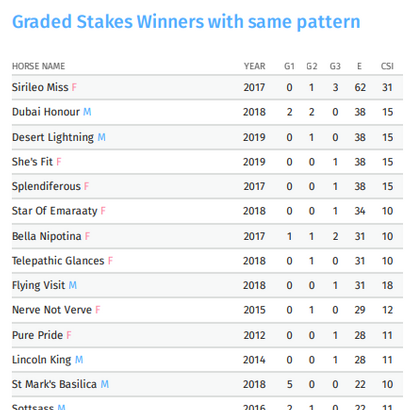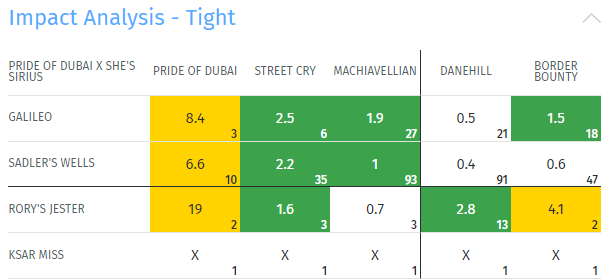Breeding Thorougbreds
We believe so and rely on G1 Goldmine as a major tool amongst the points of reference in selecting a stallion with some high affinity to our mares. Obviously, commercial factors are aslo a key pre-consideration, whether it be the service fee affordabilty or the attractiveness and/or success of a given stallion in the market and on the track.
The Impact Analysis for the mating of Sirileo Miss is the type of hypothetical mating result
we're looking for together with similarity of a proposed mating to past stakeswinners
Similary, we'll often test the breeding of a potential broodmare.
The results listed in the table and shown on the graph below provide a snapshot of the Graded Stakeswinners from around the world that have a similar pedigree to that resulting from the mating of sire and dam. Based on the G1 Goldmine concept of 'dig for gold where gold has been found before', it makes sense that our breeding plans should look to replicate the pedigrees of champion runners and the analysis should look at the entire pedigree.
Results List Columns:
'Common Similarity Index' (CSI) is a measure of how close the pedigree of a 'Graded Stakeswinner' matches a hypothetical mating. In general, values above 18 indicate a strong similarity. As a rule of thumb, if the results list shows four or more horses with CSI of 18 or above, it is usually a good mating. If the results list shows two or more horses with CSI above 20, it is usually an exceptional mating. (The results list is sorted in descending order by the CSI column, so the closest matches will appear at the top.)
E is for 'Exact' matches - this column shows a count of the number of ancestors in the five-generation pedigree which appear in exactly the same position in both pedigrees being compared.
A 20/20 Mating:
A 20/20 mating occurs when a pattern has two or more 'Graded Stakeswinners' with CSI values above 20. This indicates that the pedigree is exceptional because there are at least two superior horses with a very similar pattern. In most such cases the stud farm will offer special incentives for the breeders to send these mares to the selected stallion.

